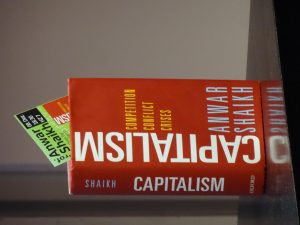Hitler Was A Lunatic, But His Crimes Were Supported By Rational, Profit-maximizing Firms
Industrialists saw the Nazi Party as a convenient partner and I.G. Farben became an essential ally of the Nazis. They were businessmen doing what any rational businessman does under a capitalist system - maximize profits. Cold rationality is an underestimated threat. The problem is systemic, the solution must be too.
Originally published by Socialist Economist (July 8, 2018).
|
|---|
About the author (click)
Lucia Huber is a Bolivian-German Marxist economist who specializes in financial crises. Follow her on Twitter: @lhuberm
I
walked through the gates of Auschwitz on an oddly cold summer day back in 2014. As a German descendant, I had always been interested (maybe more than most people are) in that obscure part of its history, and eventually all the stories I read and the films I watched led me to seek out the place. I was 24. One of the first things the guide shows you upon entering the building is the map with the layout of the entire camp. Auschwitz was divided into three parts. The first two are familiar to most people since they are the scenario of various Hollywood movies. There is the main camp Auschwitz I, where inmates worked and then the death camp Auschwitz II (Birkenau). However, it was Auschwitz III (Monowitz, or Buna-Monowitz) that caught my attention. This lesser known part of the camp stood out to me for its location. As shown in the map, it used to lie right next to the factories of I.G. Farben – a privately owned chemical and pharmaceutical industry conglomerate - which in this particular subsidiary produced synthetic oil and a type of rubber known as Buna.
This side of the camp is not part of the Auschwitz tours since the production facilities were heavily bombed and later dismantled, and there is not much left to see, but it certainly is an important part of Auschwitz´s history.
Although it was by no means the only location where the horrors of the Holocaust took place, it is maybe the most iconic one of them. Visiting the horrifying site that is Auschwitz feels like stepping into a parallel world. It seems that all human misery and all human ugliness converged in that particular place. Nothing you have read or seen in movies prepares you for the magnitude or the realness of it. The thousands of shoes, the mountains of hair, people´s names written with chalk on suitcases that were never returned to their owners, the scratches on the walls inside the gas chambers, the ashes of people burned both dead and alive, the deafening screams that cannot be heard anymore - they are more than just numbers. They are pieces of millions of individual stories.
At the end of this journey, when you take a step back and contemplate the immensity of the tragedy, you inevitably end up asking yourself how all of this could even happen. We all know the story of Hitler and the Nazis, of fanaticism, anger and scapegoating, but for the first time I began to wonder about the role that private enterprises such as I.G. Farben could have played in all of this.
On the 20th February, 1933 a secret meeting between Hitler and more than twenty industrialists took place in Berlin. Its purpose was to raise funds for the election campaign of the Nazi Party. Among those present in the meeting were representatives not only of I.G. Farben, but of other prominent companies such as Krupp AG, Siemens AG, Allianz AG, the accumulator factory AFA, as well as representatives of the steel and mining industries. In the days following the meeting many of them transferred a total sum of more than two million Reichsmark to the party through the bank of Delbrück Schickler & Co.
There is a purpose behind financing anything and this was no exception. A company handing out money to a political party does so because it expects to earn something out of it. It is not charity, but a well calculated investment. These industrialists saw the Nazi Party as a convenient partner and I.G. Farben became an essential ally of the Nazis throughout the regime - especially throughout the war.
At the end of it all, during the Nuremberg Trials the International Military Tribunal indicted 23 men under Case No. 57: the I.G. Farben Trial. The indictment alleged:
Further correspondence between those two parties revealed conversations regarding experiments run on female inmates:
This side of the camp is not part of the Auschwitz tours since the production facilities were heavily bombed and later dismantled, and there is not much left to see, but it certainly is an important part of Auschwitz´s history.
Although it was by no means the only location where the horrors of the Holocaust took place, it is maybe the most iconic one of them. Visiting the horrifying site that is Auschwitz feels like stepping into a parallel world. It seems that all human misery and all human ugliness converged in that particular place. Nothing you have read or seen in movies prepares you for the magnitude or the realness of it. The thousands of shoes, the mountains of hair, people´s names written with chalk on suitcases that were never returned to their owners, the scratches on the walls inside the gas chambers, the ashes of people burned both dead and alive, the deafening screams that cannot be heard anymore - they are more than just numbers. They are pieces of millions of individual stories.
At the end of this journey, when you take a step back and contemplate the immensity of the tragedy, you inevitably end up asking yourself how all of this could even happen. We all know the story of Hitler and the Nazis, of fanaticism, anger and scapegoating, but for the first time I began to wonder about the role that private enterprises such as I.G. Farben could have played in all of this.
On the 20th February, 1933 a secret meeting between Hitler and more than twenty industrialists took place in Berlin. Its purpose was to raise funds for the election campaign of the Nazi Party. Among those present in the meeting were representatives not only of I.G. Farben, but of other prominent companies such as Krupp AG, Siemens AG, Allianz AG, the accumulator factory AFA, as well as representatives of the steel and mining industries. In the days following the meeting many of them transferred a total sum of more than two million Reichsmark to the party through the bank of Delbrück Schickler & Co.
 |
| Adolf Hitler (left) and industrialist Gustav Krupp (right) receiving the golden medal from the Nazi Party (Wikimedia Commons). Auschwitz map (background) showing I.G. Farben factory (Martin Gilbert, 1985). |
There is a purpose behind financing anything and this was no exception. A company handing out money to a political party does so because it expects to earn something out of it. It is not charity, but a well calculated investment. These industrialists saw the Nazi Party as a convenient partner and I.G. Farben became an essential ally of the Nazis throughout the regime - especially throughout the war.
At the end of it all, during the Nuremberg Trials the International Military Tribunal indicted 23 men under Case No. 57: the I.G. Farben Trial. The indictment alleged:
“All of the defendants, acting through the instrumentality of Farben and otherwise, with divers other persons during a period of years preceding 8th May, 1945, participated in the planning, preparation, initiation, and waging of wars of aggression and invasions of other countries, which wars of aggression and invasions were also in violation of international laws and treaties. All of the defendants held high positions in the financial, industrial and economic life of Germany and committed these crimes against Peace, as defined by Article II of Control Council Law No. 10, in that they were principals in, accessories to, ordered, abetted, took a consenting part in, were connected with plans and enterprises involving, and were members of organizations or groups, including Farben, which were connected with the commission of said crimes.”
Among those found guilty were Otto Ambros, the production chief and Fritz ter Meer who was in charge of the chemical plant in Monowitz, which had been built right next to the concentration camp.
“The evidence showed that at a conference in the Reich Ministry of Economics on the 6th February, 1941, the planning of the expansion of Buna rubber production was discussed. The accused Ambros and ter Meer were present. Farben was instructed to choose an appropriate site in Silesia for a fourth Buna plant. It appeared that, pursuant to this instruction and upon recommendation of the accused Ambros, the site at Auschwitz was chosen. The evidence was conflicting as to the importance of the concentration camp there located in deciding upon the location of the plant, but it seemed clear that while the camp may not have been the determining factor in selecting the location, it was an important one, and from the beginning it was planned to use the concentration camp labor to supplement the supply of workers.”
I.G Farben had the task of making Germany self-sufficient in essential materials needed for the war effort. The privilege of supplying the German army in the most costly war of all times rendered them exuberant profits. It was the only company to run its own concentration camp, using a workforce of altogether 300,000 people throughout the years it operated there. This allowed I.G. Farben to practically eliminate labor costs and to keep the factory running day and night, yielding a level of efficiency impossible to reach under normal circumstances. Furthermore, it allowed the company to use camp inmates for medical experimentation. It was everything any industrialist could only have fantasized about. For some, war is a magnificent business opportunity. ‟In such a time in history, when the meaning of everything is redefined and the limits of what is acceptable are redrawn, crime is no longer considered a crime and therefore it abounds.In such a time in history, when the meaning of everything is redefined and the limits of what is acceptable are redrawn, crime is no longer considered a crime and therefore it abounds. Among the documents of I.G. Farben a letter sent to the camp commander was found, where the company requested the “harsh” punishment of an inmate by the number 157 040, without giving any details as to why he was to be punished.
| Source: Dr. Rath Health Foundation |
Further correspondence between those two parties revealed conversations regarding experiments run on female inmates:
“With a view to the planned experiments with a new sleep-inducing drug we would appreciate it if you could place a number of prisoners at our disposal (…)” – “We confirm your response, but consider the price of 200 RM per woman to be too high. We propose to pay no more than 170 RM per woman. If this is acceptable to you, the women will be placed in our possession. We need some 150 women (…)” – “We confirm your approval of the agreement. Please prepare for us 150 women in the best health possible (…)” – “Received the order for 150 women. Despite their macerated condition they were considered satisfactory. We will keep you informed of the developments regarding the experiments (…)” – “The experiments were performed. All test persons died. We will contact you shortly about a new shipment (…)”
After contemplating these and other pieces of evidence, the Military Tribunal found that:
“The plight of the concentration camp inmates, however, was that of extreme hardship and suffering. With inadequate food and clothing, large numbers of them were unable to stand the heavy labor. Many of those who became too ill or weak to work were transferred by the S.S. to Birkenau and exterminated in the gas chambers. Neither was the plant site entirely without inhuman incidents. Occasionally beatings occurred by the plant police and supervisors. It was clear from the evidence that Farben did not deliberately pursue or encourage an inhuman policy with respect to the workers. In fact some steps were taken by Farben to alleviate the situation. Despite this fact, however, it was evident that the accused most closely connected with the Auschwitz project bore great responsibility with respect to the workers. They applied to the Reich Labor Office for labor. They received and accepted concentration camp workers. They took the initiative for the unlawful employment and were aware of the sufferings and hardships to which they were exposed.”
Were these men blackmailed to donate to Hitler´s election campaign? Were they forced by the Nazi regime to participate in the war effort? Maybe we can debate that. One thing is certain, though: they profited from it. Not only was I.G. Farben the single largest donor, but also the single largest profiteer from WWII. They were, however, not the only industrialists tried at Nuremberg. There was also the Flick Trial and the Krupp Trial, where similar findings were made.
‟They partnered with the beast, assisted it and profited thanks to it, becoming complicit in its crimes, not necessarily because they shared the ideals, but because it was good for their business - it was a rational decision.
When we speak about the perpetrators of the Holocaust we always think of lunatics, racists and xenophobes like Hitler himself, of sadists like the Beast of Belsen and the Butcher of Lyon, or of perverted minds like the one of Dr. Mengele. The fact that people can be capable of such evil certainly is terrifying. However, it is not this type that intrigues me the most. History has characterized such individuals as insane, deeply disturbed, delirious, as persons that were “out of their minds”, and whose actions and incentives can be considered irrational to a wide extent. I am more intrigued by those whose names remain in the shadows of the more picturesque criminals. I am talking about average human beings, not particularly hateful nor resentful, not racist, or fanatic or blood thirsty. I am frightened of rational human beings. As outlined in the excerpt above, they – and others like them - did not deliberately seek or encourage inhuman treatment. Many of them were probably not even anti-Semitic at all. They were just businessmen doing what any rational businessman does under a capitalist system - maximize profits. Cold rationality is an underestimated threat. We might think that the pursuit of profit maximization will stop at a certain border, that it will not trespass the threshold of respect for basic human decency and compassion. But businessmen were not at Auschwitz, they did not smell the stench of burning bodies. They did not hear the screams of agony of those scratching the walls inside the gas chambers. Most of them were miles away from the hellholes they had helped to create, seeing nothing of the collateral effects of the decisions they had made. They filled their pockets and grew their businesses and let the victims to their own fate, often telling themselves that there was nothing they could do to stop the beast of war and murder. But it was the campaign contributions of these rational financiers and industrialists that fueled the beast in the first place. They partnered with the beast, assisted it and profited thanks to it, becoming complicit in its crimes, not necessarily because they shared the ideals, but because it was good for their business - it was a rational decision.
I remember someone asking me why any of this mattered anymore today.
After the company´s managers had been convicted, I.G. Farben was dissolved and it split back into its four largest original constituent companies: Bayer, Agfa, BASF and Hoechst (now Sanofi). Among the indicted board members was the director Fritz ter Meer. He was found guilty of plunder and spoliation as well as enslavement and mass murder, and sentenced to seven years in prison, of which he only served two, due to “good behavior”. In 1955 he became the supervisory board chairman of Bayer. In his honor Bayer established the Fritz-ter-Meer-Stiftung, a foundation that today runs under the name of Bayer Science & Education Foundation and grants scholarships to chemistry students. In 2013 Bayer celebrated its 150th anniversary - an act by which it confirmed that it considers itself to be the same company that it was before and during the war. The German chancellor Angela Merkel who attended the event proudly proclaimed Bayer, a company that financed the Nazi regime, profited of slave labor and honored a convicted war criminal, to be a “flagship” for Germany – whatever that may be.
Why it still matters today? Aren´t there wars being fought today? Isn´t it possible that there are companies profiting from them? And beside wars, aren´t there other crimes being committed by private enterprises?
In the 1980s a subsidiary of Bayer called Cutter Biological produced a blood clotting medicine for hemophiliacs known as Factor VIII concentrate. Its production required blood plasma from healthy donors. However, big demand led pharmaceutical companies to purchase blood from prisoners and drug addicts, creating a risky pool of blood. Without undergoing a necessary heating treatment to eliminate possible H.I.V. infections, the blood became a potentially contagious ingredient and hemophiliacs all over the world who used this medicine became infected with H.I.V. and many of them died as a consequence. The company introduced a safer, heated version of the medicine, which it primarily marketed in Europe and the U.S., but continued to sell the remaining stocks of the older version in developing countries. “There is excess non-heated inventory” the company noted in minutes of a meeting held on Nov. 15, 1984 and it planned to “review international markets again to determine if more of this product can be sold.” The company was fined and forced to pay compensations but no one was held criminally responsible.
The problem lies not within an individual or a company. I.G. Farben and Bayer are just glaring examples of how far things can go in the name of profit. More and more often corporations are caught cheating, marketing unsafe products, manipulating research results, manufacturing their products in sweatshops, committing or being complicit in all sorts of crimes. Exxon Mobil is being investigated for misleading the public on the risks of climate change. Monsanto was found guilty of contaminating the water of an entire community in Alabama with toxic chemicals, Nestlé is facing a lawsuit alleging child and slave labor being used in their chain of supply. The list goes on and on. How many executives are ever indicted? How many serve time in prison? How significant are the fines the companies pay compared to the benefits they get from immoral and criminal activities? One of the first lessons any business student learns is that if the profits earned from a certain activity exceed the costs, then it is optimal to engage in it. Well if the costs (fines and punishment) are so minimal compared to the profits, then it can be no surprise that these things keep happening.
‟The hand of justice falls like a fist on the weak and at the same time pets the powerful with an open palm.
Criminals are treated with great disparity. A kid smoking pot is put behind bars while a bank like HSBC launders money from drug cartels and gets away with a fine and a pledge to avoid further bad behavior. The hand of justice falls like a fist on the weak and at the same time pets the powerful with an open palm.
The rationality of corporate crimes is vindicated every time they remain unpunished or when imposed sanctions represent a tiny fraction of the revenue of said crimes. When lobbying is permitted and encouraged, when corporations can put their representatives in public offices, when authorities are either too weak or unwilling to enforce the law, when the supervised is also the supervisor, and when corporations effectively become the government, then the concept of corporate crimes falls into a grey zone.
I used to believe that if we could educate and sensitize the decision makers inside those corporations to respect a moral borderline, that would solve the problem. It took me some time to see that this would require them to act irrationally. The problem is systemic. It is a system of skewed incentives that puts profit above the law, above people and above life itself. So if the problem is systemic, the solution must be systemic, too. Trying to rein in unmoral and criminal behavior has proven to be useless. If we want to see different results, we must create a system in which it is rational to respect each other, to strive for peace and to value life. It may sound utopian, but when we find ourselves living in dystopian times, superficial change - I am afraid - will not lead us out of the woods.























Comments
Post a Comment
Your thoughts...